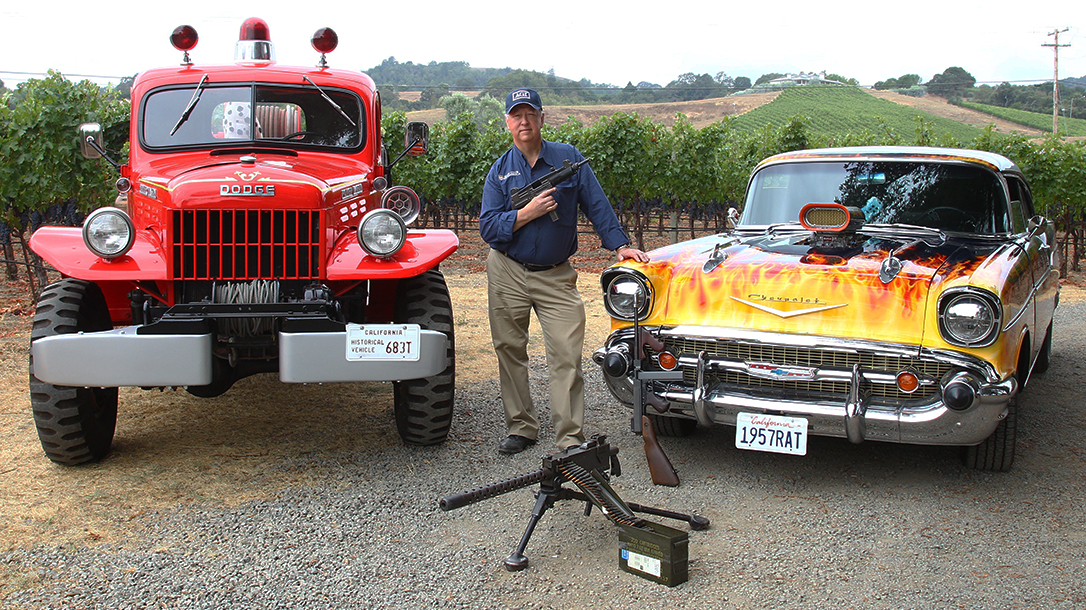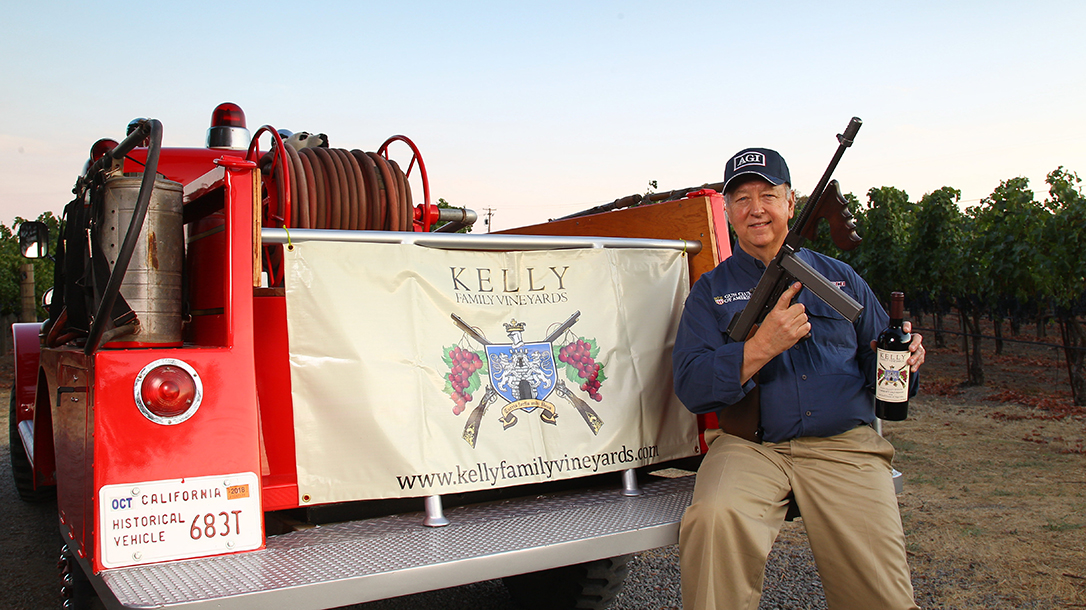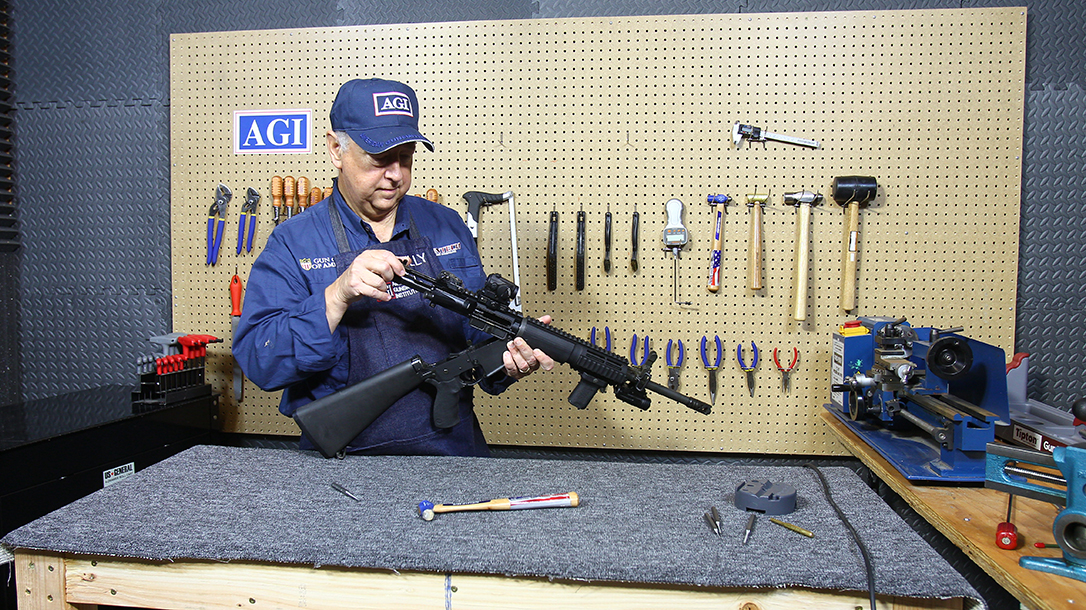There’s a saying that guns and alcohol don’t mix. For the most part, that is both sage and prudent advice. But like all generalities, there are exceptions, and Gene Kelly (aka “Machine Gun Kelly”) is one. Why? Well, at one time he owned as many as 250 machine pistols, submachine gun and belt-fed machine guns. As for the alcohol part, Gene also owns Kelly Family Vineyards, a precious 10-acre tract of land smack in the middle of Napa Valley, America’s gift to the world of wine. Gene is also the founder and president of the American Gunsmithing Institute, which offers self-paced video and online instructional courses conducted by master gunsmiths.
Gene Kelly of the American Gunsmithing Institute
When Nino Bosaz, Athlon Outdoor’s Editorial Director, put me onto Gene as a possible subject for an article, I began my first email to him thusly: “Yo, Gene, Nino at Athlon put me onto you. Loved ya in Singin’ in the Rain. You’re much more athletic than Fred Astaire.”
Advertisement — Continue Reading Below
Oh well, at least I thought it was funny. With the same name as the Hollywood actor, dancer and director of the 1940s through 1990s, along with the machine gun tie-in, Gene assured me he gets stupid comments like mine all the time. Anyway, the more I learned about him, the more it became obvious that this was one interesting guy.
It all started in 1977. After graduating high school and having given college a brief try, Gene enrolled in the School of Gunsmithing at Lassen Community College. Upon completing the 2.5-year course and graduating at the top of his class, he went to work for master gunsmith Bob Dunlap, who had been his senior instructor at Lassen and who had a large gunsmithing business on the side. By doing so, Gene broadened and perfected his skills not only as a gunsmith and gun builder, but also as a highly accomplished handgun and rifle shooter as well. Deciding to put those skills to work, Gene went to Israel in 1986. There, he trained with the Israeli military and earned certification in security and personal protection. For the next seven years, Gene traveled the world, protecting high-level diplomats and celebrities.
“I can’t name names for you, Jon, but if I could, you’d recognize many of those for whom I provided personal protection or arranged security. It was interesting work, and I got to see the world, but the travel got to be too much. Besides, I had plans of my own.”
Advertisement — Continue Reading Below
Founding the American Gunsmithing Institute
Those “plans” were the founding of the American Gunsmithing Institute in 1993. Gene believed that not everyone who wanted to be a gunsmith could take 2.5 years off from a paying job to attend a college. According to him, a person could be looking at $100,000 in lost wages and expenses. There had to be a better, faster way to turn out competent gunsmiths, he believed, and the need for them was ever-growing. So he went to his mentor, Bob Dunlap, who was about to retire from Lassen. Together, they filmed what fleshed out to be 108 hours of professional video documenting Bob’s design-function-repair methodology for centerfire rifles, shotguns, pistols and rimfire rifles. It took more than two years to put the program together.
“A picture may be worth a thousand words,” says Gene, “but moving pictures are worth tens of thousands. Trying to explain intricate procedures in a book is very difficult, but on video we can show how to do it, and it can be reviewed as many times as it takes, plus each student has an instructor assigned to him who’s available to answer any and all questions.”
Over the past 23 years, literally thousands of gunsmiths have graduated from the American Gunsmithing Institute and gone on to develop highly successful businesses. Perhaps most gratifying for Gene is that many of those successful graduates are disabled veterans, for any vet with a 30-percent disability or more is eligible for the Department of Veterans Affairs to pay for their gunsmithing education and tools.
Advertisement — Continue Reading Below
The Accelerated Training Institute
And with the success of the American Gunsmithing Institute, it was inevitable that Gene would see the efficacy of applying that same methodology to other vocational areas. In his book The College Myth, he points out that around 70 percent of high school graduates would be much better off career-wise developing a skill that is in demand. There is an acute shortage, he says, of qualified people who can do things and fix things. So, in 2010, he started the Accelerated Training Institute (ATI). ATI offers video courses in plumbing, electrical, machining, welding, locksmithing, masonry/tile and carpentry that, in six months’ time, can result in one becoming a certified technician with the earning potential of six figures.
“Machine Gun Kelly”
As he was growing his business, Gene developed a keen interest in automatic weapons—machine pistols, submachine guns and machine guns. While he was working for companies under contract with the government—licensed to acquire all types of surplus weapons for dismantling and destruction—literally thousands of handheld and belt-fed machine guns passed through his hands, guns like Sten Mk IIs, Sterling Mk 4s, Browning 1919A4s and Swedish Ks, to name a few.
Advertisement — Continue Reading Below
When I visited him in late August, his personal collection had dwindled to a mere 50 such guns. It’s no wonder, then, that he has long since acquired the “Machine Gun Kelly” moniker. His favorite is the Thompson, but that came as no surprise to me, for just about every machine gun weenie I’ve ever met has a thing for this iconic firearm that is so closely associated with the bootleggers and gangsters of the Prohibition era. The real Machine Gun Kelly (Kelly was his middle name; his surname was Barnes) died on his birthday, July 18, 1954, at the age of 59 in Leavenworth Penitentiary, where he was serving a life sentence for kidnapping oil tycoon Charles Urschel in 1933.
When in Napa
Now for the alcohol tie-in. Gene’s branch of the Kelly family immigrated from Ireland in the late 1800s. However, they didn’t settle in the Napa Valley until 1968. Wine was such a part of daily life that it was only natural that Gene became a wine lover. Having always lived in tract homes, he promised that one day he would acquire land somewhere in the valley; if it happened to have a vineyard on it, so much the better!
It took two years of looking, but early in 2012, Gene found a house for sale situated on a 10-acre vineyard in the Oak Knoll District in Napa. The owner had run into some financial difficulty, and the home had been virtually abandoned and was in disrepair. The vineyard, however, had a viable crop of Merlot grapes. Long story short, Gene, his wife, Paula, and son, Jacob, moved into their renovation-in-progress home later that year. Gene arranged to have his harvest sent to the Napa Wine Company, where small vineyards like his can have their grapes turned into extraordinary wines under the supervision of some of Napa’s most celebrated oenologists.
Advertisement — Continue Reading Below
As unlikely as it seemed, the newly minted Kelly Family Vineyards’ first bottled vintage, a 2012 Merlot, raised a lot of eyebrows in the Napa community with its quality. Being a truly boutique wine, its yield that year was only 200 cases, and it sold more quickly than Gene expected. What followed then was, to my mind, truly remarkable.
A Winning Vintage
In Napa, the Cabernet Sauvignon grape is king, as it is in Bordeaux; it’s with those grapes that the most money can be made. So, in April of 2013, Gene severed his entire Merlot root stock about 18 inches above the ground and onto it grafted Cabernet vines.
Most amazing to me was that, seven months later, he not only had a viable harvest of Cabernet Sauvignon grapes that yielded nearly 300 cases of wine, but his wine also won a gold medal at the 2017 San Francisco Chronicle (SFC) Wine Competition, the largest event of its kind in the country. And this was against some serious heavy hitters in the Napa wine industry—names you’d surely recognize if you’re into wine at all. But then for an encore, Kelly Family Vineyards’ 2014 Cabernet Sauvignon won Double Gold at the 2018 SFC competition.
Advertisement — Continue Reading Below
Production
Gene’s 10 acres of vines are capable of producing about 2,000 cases of wine, but for the time being, he’s content with staying a small, boutique-type operation. As such, he’s using only 20 percent of his vineyard for his own wine; the rest of the harvest is sold to his neighbor, Stags’ Leap, a well-known and highly respected winery whose owner thinks so much of Kelly Family Vineyards grapes that they have offered to buy the entire 2018 harvest—an offer Gene refused. Simply selling all of his grapes would make life much easier, for there are always risks involved in the wine-making process, but there’s nothing like having your own name on an award-winning Cabernet from Napa Valley.
When I visited Gene at the end of August, he was about to release his 2015 vintage, of which there will be about 400 cases. As I write this, his 2014 is selling for around $85 per bottle. Meanwhile, the 2015 will be going for $100. It’s no wonder he doesn’t want to sell all his grapes!
Cars Too!
As if he didn’t have enough interests, Gene is also into vintage American cars. He recently purchased a completely restored 1956 Dodge Power Wagon fire truck that saw service in Napa, and which he drives in local events and parades. It’s the most fantastic truck restoration I’ve ever seen. He also owns a pristine 1957 Chevy with a big-block 454-cubic-inch mill bored to 468 that generates 560 horsepower. When he blips it, the ground shakes. It also sports a paint job you have to see to believe.
Advertisement — Continue Reading Below
As I wrote at the outset, generally speaking, guns and alcohol don’t mix. But there are exceptions. Just ask Gene “Machine Gun” Kelly.
This article is from the spring 2019 issue of Ballistic Magazine. Grab your physical copy at OutdoorGroupStore.com. For digital version, head over to Amazon.

























